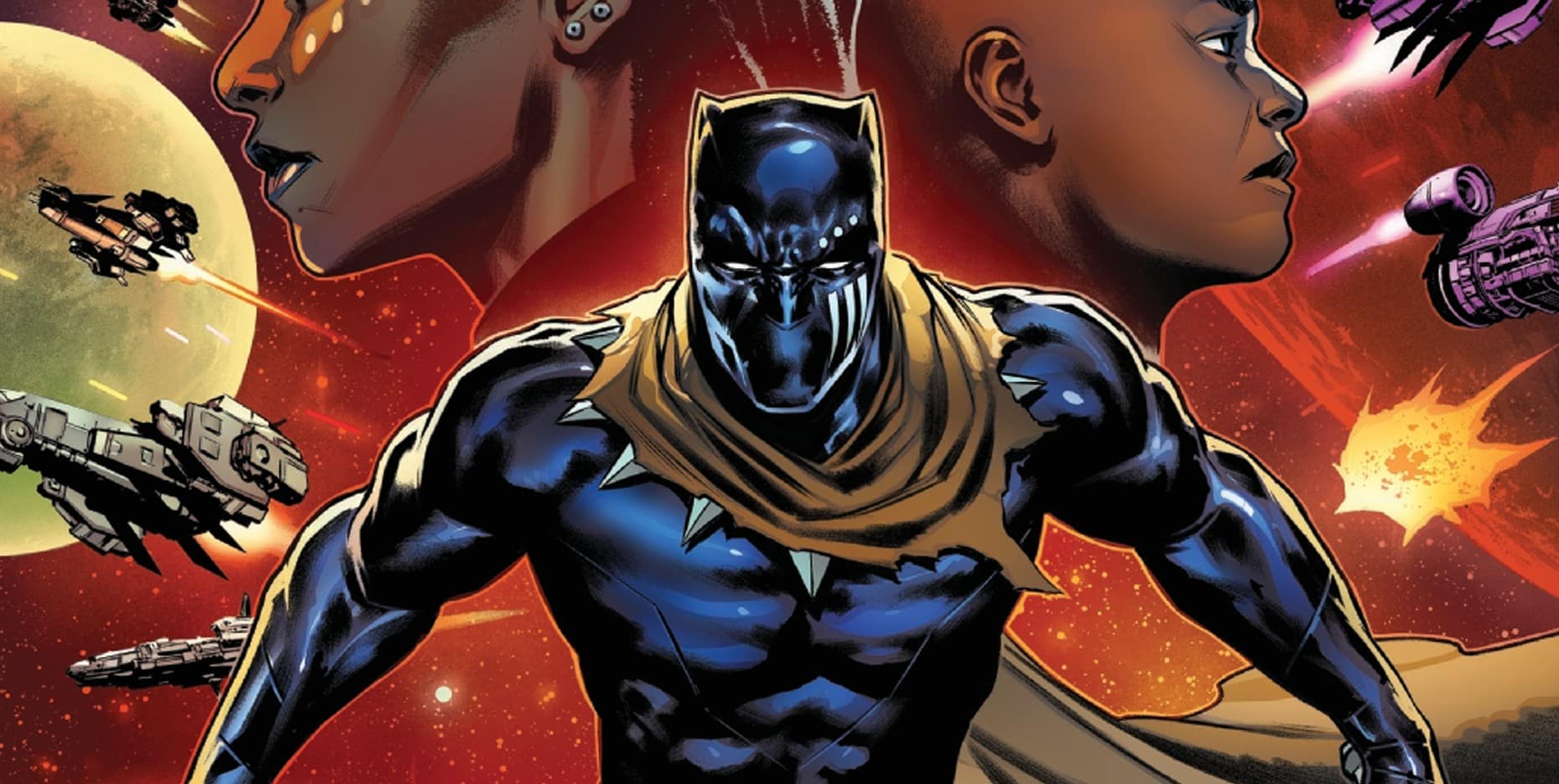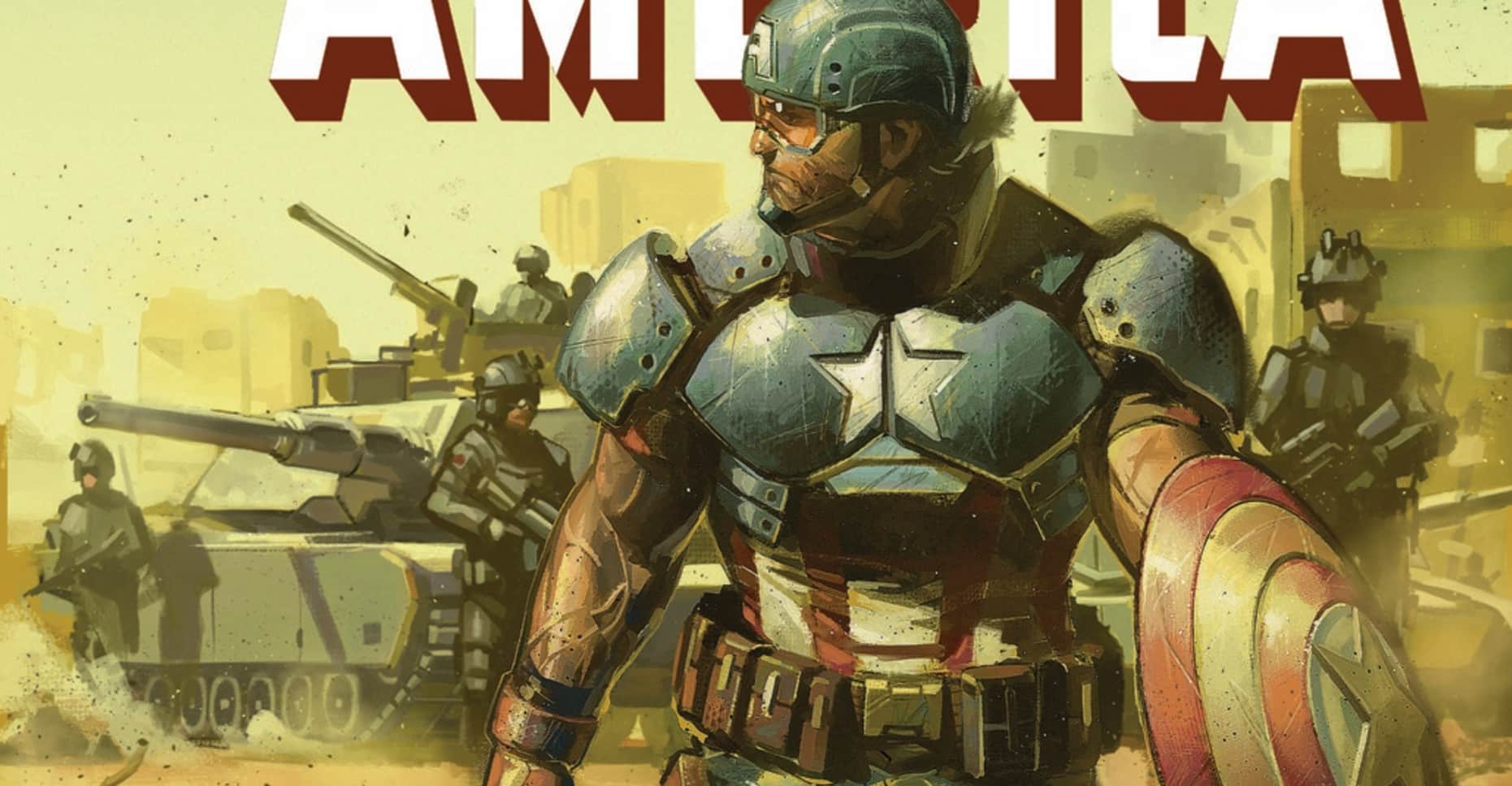With Valeria Richards at his side, Victor Von Doom goes on a quest to harness more power than any human has ever wielded to try to stop Galactus from bringing about the death of the universe. Will he succeed, or are we all … doomed? Doom #1 is by Sanford Greene and Jonathan Hickman, with additional colors by Rachelle Rosenberg and letters by Joe Caramagna.
On the face of it, Sanford Greene and Jonathan Hickman’s Doom is a spectacular comic about the Marvel Universe’s great immovable object’s last stand against its unstoppable force; about its greatest foe becoming its last great hope; about a battle between Doctor Doom and Galactus.
It’s also about some of the Marvel Universe’s most foundational truths: that these two hubristic, tragic figures are eternally doomed to fail; the inevitable heat death of the universe; that everything dies and that everything lives.
It’s also about Marvel Comics’ most foundational truths: that the company itself is a tragic figure perpetuating its own tragic flaw; the inevitable cancellation, or reboot, or reset; that all good things end too soon; and that it’s the resilience, persistence and hope of its creators that breathes life into this universe. This is a battle of a different kind — one for the future of the comics industry.
In case you haven’t read the issue, it goes a little like this: At an unspecified point in the future, Valeria Richards finds Doctor Doom floating amid the debris of the dying embers of the universe. Bent and broken, Valeria nurses Doom back to health as she explains that his attempts to stop the unprecedentedly ravenous advances of Galactus through Earth and the universe had failed. We see, through several sublime showcase pages for Greene, Galactus tearing through the planet and galaxy’s heroes and advancing through its Celestials with ease. This current cosmos can no longer sate Galactus’ hunger; he plans to bring about its death and rebirth so he can finally fulfill his appetite. Knowing that much has been lost already, but that there is still plenty worth saving, Valeria and Doom take on Galactus and his heralds. Valeria dies destroying Galactus’ Ultimate Nullifier machine as Doom strides forth to take on the Universe Eater.
The Universe Eater

Doom #1 is simultaneously a criticism of the crumbling foundations of the comics industry and a love letter to the creators rebuilding its infrastructure while fixing the leaks in the ceiling. It is a high-concept comic book in which Doom is the relentlessly inventive and eternally stubborn creative doing the exceptional to hold back the unstoppable, destructive force of stagnation that leads to endless returns to nostalgia; to rail against the risk aversion that leads to continued early cancellations of ongoing series; to dare to hope even against the futility of the prioritization of cash flow over sustainable growth in the miniseries-reboot-miniseries cycle. Through Doom, Hickman makes the argument that the continued short-termism and conservatism of the corporate forces in comics is what is precipitating its decline, even with the increased visibility the MCU juggernaut gives these characters and stories.
Galactus represents the corporate decision making machinery that is defined by its ravenous pursuit of a quick buck over creative merit or the runway for a creator to build success over time. He is the gnashing jaws of both a ravenous and famished industry that is losing its way.
“This? This is its monstrous mother — a nameless entropic nightmare. A universe killer… and a universe creator. The death of one… so that it may be replaced by another.”
Marvel in particular’s tendency toward cancelling and rebooting a series just for the sales boost of first issues is well-documented at this point. It is a source of frustration for fans and creatives alike because without the continuity of a genuine ongoing series, a story’s scope naturally becomes more limited. More than that, though, the universes that creators build within their stories are destroyed more and more frequently because of decisions made in board rooms, whose vision of the creative process is defined by destruction.
“Galactus, it seems, is tired of waiting for his role: to witness the end of one universe and the start of a new one born from its destruction.”
Galactus’ journey through the Marvel universe sees him barrelling through the layers of the corporate structure one by one. After working his way through the universe’s heroes, the creators, he confronts the Celestials. Responsible for shaping and maintaining the universe’s continuity, the editors who preside over these story worlds are ostensibly their protectors. And Galactus would make war with them. The Heralds who “watch his back as he feeds the machine from his many feedings” are those who use data to determine creative merit and signal the destruction of a fictional universe. This is also potentially referencing the idea that the Marvel Comics universe has been reduced to a data set to be mined to birth the next phase of the Cinematic Universe.
The construction of this story applies to the lived experience of a creator whose morale is decimated by having the fate of their universe decided by someone in a boardroom. It is telling that rather than working his way down the likely organizational chart through editorial, marketing and eventually to the creator, Greene and Hickman have Galactus build upward through the layers of creativity, destroying and consuming the stories as he goes.
This in and of itself would look pretty bleak, but don’t forget: This is a superhero comic. Hope is built into the design, so to which hero do we turn to hold back the industry’s doom? Ironically, to the man himself.
Doom Endures

If Galactus represents the corporate machinery, then who is Doom? It would be tempting to declare, as the scripter, that he represents Hickman himself. First of all, I think exploring the intention of a writer is verging into the realms of supposition and should therefore be avoided. Secondly, the scale of this story is universal, as are the themes. It’s safer to say that Doom represents all creators who operate within the universe of Big Two comics.
Hickman’s scripting of Doom’s internal monologue reflects on the creator’s role within this system and balances feelings of guilt and sadness with defiance and positivity. One thing Doom, and by extension Hickman, is clear on, though, is that there is no room for regret. It’s easy to imagine Hickman reflecting on his own experiences here, but again I would caution reading into this as too much of a personal reflection. If the feeling of having your universe snatched from you can be this keenly felt by one of comics’ most successful writers, imagine how it feels for everyone else.
“They are praying for someone to hold up something that is already collapsing around them. A god came to Earth and judged it — Galactus judged the Earth… And he found that we were not worth saving.”
Hickman is reflecting on any creator’s sense of powerlessness against the inevitable heat death of their universe. Ultimately, everything dies. For Hickman, this has always been a universal truth, but it is not something readers always understand or have sympathy for. A creator can only do so much when someone has the power to simply ride the escalator down from the top floor and kill a story. In “the land of the short-lived” as Valeria describes it, how can those not “seduced by the short-term satisfaction of victory” survive?
They endure.
If you must accept that everything good will end, all one can do is to continue creating, to accept that you can’t change the past and that you must live with your mistakes, to continue to approach every story with hope and optimism that what you create will live on in canon, in the hearts and minds of readers. Because, as many of Hickman’s creations are a testament to, some comics are immortal.
“Life ends for all of us. So accept it… head held high. Refusing to be judged by what gods remain in the universe… And unscarred by whatever sins lie in your past. When all that remains is one final moment of defiance… embrace Doom and laugh in its face.”
The last page is such a beautiful distillation of these themes, achieved by brilliant page composition by Sanford Greene, and it’s fitting that it’s left on a cliffhanger. Doom stares up at Galactus, paling in significance against his planetary-size frame. Galactus’ eyes are fixed on Doom, preparing to wipe out the last vestiges of a universe he has found wanting. What he cannot see that both Doom and the reader can are Marvel’s cosmic entities, those beings who comprise the very fabric of the universe, staring down at him either in hope or in judgment. It’s hard not to think of Jack Kirby in this moment as the chief architect of the Marvel Universe and both characters’ creators. Hickman and all of those who create in this universe are its greatest custodians. But they’ll be fighting with one hand tied behind their back. After all, superhero comics have always been about achieving the impossible.
Will they succeed? I guess the next few years will tell.
Buy Doom #1 here. (Disclaimer: As an Amazon Associate, ComicsXF may earn from qualifying purchases.)
Jake Murray spends far too much time wondering if the New Mutants are OK. When he's not doing that, he can be found talking and writing about comics with anyone who will listen. Follow him @stealthisplanet.bsky.social.






